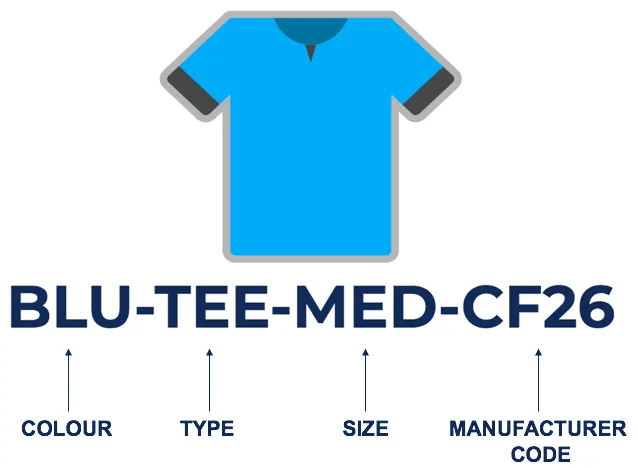What Is SKU In Inventory Management?
- 03/11/2022
- Philip K
More and more orders. Is your e-commerce inventory becoming harder to organize and track? Do you want to keep inventory and get data on it? This is your time to Use SKU numbers for inventory management. Designing an SKU system to sort inventory will save you even more time and meet customer 1-2 day delivery expectations.
Follow this article then takes you through how SKU in inventory management can help your business maintain control over sales and profitability.

What is SKU?
SKU (Stock Keeping Unit) in inventory management refers to the number assigned to the product. For manage inventory and easy product tracking. In other words, an SKU is the unique identifier of the product sold by the retail trademark.
Typically used by retail stores, warehouses, and product fulfillment centers. Generally, SKUs are divided into two different categories: classification and category.
Some retailers create their own unique code based on the characteristics of their products. This allows retailers to track inventory, analyze sales by product category, and even use this number to design store layouts and processes to enhance the consumers’ shopping experience.

What is the difference between SKU, EAN, and UPC codes?
Many people confuse SKU with EAN or UPC codes (collectively referred to as “barcodes”). The following table shows the main differences between them:
SKU (Stock Keeping Unit): A coding classification method after products are put into storage.
EAN (European Article Number): A barcode for commodities developed by the International Article Numbering Association and used in the world.
UPC (Universal Product Code): A commodity barcode developed by the United States Uniform Code Committee.
Used to manage inventory.
What are SKU Numbers?
An SKU number is a combination of letters and numbers. These combinations of numbers and letters provide detailed information about the product. Such as its make, model, size, color, and more.
Each merchant creates SKUs for products in their own way. Simple and easy-to-understand SKU numbers are the most effective.
Best Practices for SKU in Inventory Management
Example of Building an SKU in inventory management
Let’s assume that the SKU assigned to a particular product is: a medium blue body.
We can build the following SKUs for this product: blu-tee-med-CF26

Detail:
Why Use SKU in Inventory Management in E-commerce?
SKU numbers are used in both e-commerce and retail. There are several main reasons why e-commerce businesses use SKUs:
Achieve Efficient Inventory ManagementThe uniqueness of SKU in inventory management provides a way to differentiate between different categories of products. It also makes it easier for you to monitor and manage inventory status in real-time, and analyze individual product inventory levels, changes in storage locations, and sales, which also helps you make more informed decisions.
A clear SKU system reduces human error during picking, packing, and shipping.
Get SKU Product DataData is the basis for analyzing customer needs.
By adding SKUs to all your products, you can collect data from inventory out-of-stocks to better analyze and make changes to your best-selling and non-selling products.
Predict Future Sales TrendsSKU in inventory management enables segmentation and tracking of each specific product. Study the different performances of each product, observe the order value and quantity of different products, and analyze the preference trend of the target customer group.
From there, you can more accurately forecast demand, so you can make inventory adjustments or adjust marketing strategies to meet customer demand.
Set The Product Inventory LocationWithout a system to fix and differentiate products, it is difficult to replenish inventory by ordering products in a timely manner. By assigning an SKU to each product, you gain a new level of inventory visibility and can quickly identify which inventory levels are below the tipping point of replenishment. You can also set automatic reorder points for each SKU.
By subdividing specific products through SKUs and fixing the location, you can accurately find the location during replenishment, otherwise, it will be a great waste of manpower.
How to Create SKU Numbers for Products?
Your business should establish a set of criteria for creating and assigning SKUs.
For example, what attributes the SKU catalog has, and how the order in which the attributes of the product information are presented. Such as product category, color, size, model, etc.
The purpose of the only SKU in inventory management is to distinguish each product from all others, so two different products having the same SKU is not for the purpose. The exact same item may have two different SKUs in two different businesses.
One of the biggest benefits of SKUs is that they allow you to differentiate particularly similar items and sell them together on physical shelves and in online stores.
Differentiating similar products with similar SKUs not only keeps inventory organized, but also recommends alternatives to the same type of product to customers when they sell out of the goods they need, even if the customer is satisfied and the sale is completed.
When creating an SKU system, remember to record the dimensions and weight of each SKU. Many businesses tend to skip this step, but it’s necessary to accurately estimate your inventory capacity.
SKU management systems can simplify SKU tracking over time and facilitate inventory counting. Whether it is for physical stores or warehouses, or for accounting purposes, it is very convenient.
Inventory management software can automate most SKU management processes and provide detailed visibility into SKU levels, assortment, order history, sales records, and shipping confirmations.
Finally, I would like to say that for SKU generators, although you can use the generator, it is best to write according to your own management habits.
Take the Amazon platform, whether you build new products or sell existing products, you need a corresponding SKU in inventory management, about the SKU writing rules, Amazon does not strictly require, the SKU column can be filled in by the seller himself, if not filled in, Amazon will automatically generate an SKU code assigned to you, although it is very trouble-free, this will make it difficult to identify. Therefore, in order to facilitate the management of products in the future, it is best for sellers to write SKUs according to their own management habits or product characteristics.
Conclusion
SKU system is a must to keep your inventory and manage everything in order. The handling of SKUs is actually very complex and time-consuming. So you also need 3PL cooperation with technical support. Outsourcing inventory storage and order fulfillment to Honest FulPhilment can help you focus more on your core competencies while saving you time. Contact us now.
FAQ about SKU In Inventory Management:
Need a Quick Quote?
– Competitive price
– Quote within 24 hours
– 30+ Shipping methods
– Dedicated account manager
– Shopify/Woo integrations
– Autofulfil
– Auto tracking
– Plus much, much more

5 Best Wholesale Home Decor Suppliers 2023



10 Best Bikini Brands For Summer 2023








